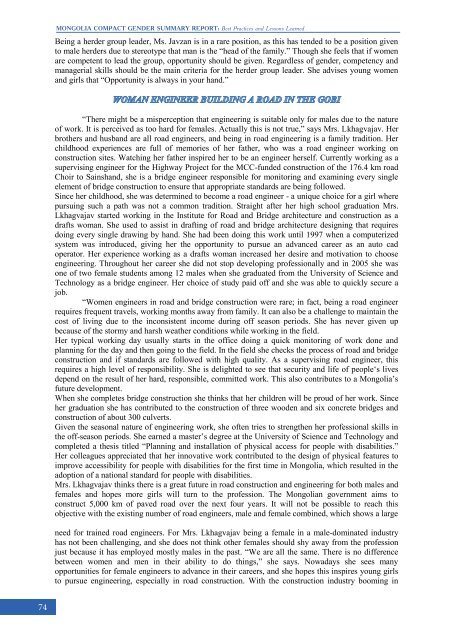Ulaanbaatar 2013
Ulaanbaatar 2013
Ulaanbaatar 2013
You also want an ePaper? Increase the reach of your titles
YUMPU automatically turns print PDFs into web optimized ePapers that Google loves.
Mongolia Compact Gender Summary Report: Best Practices And Lessons LearnedBeing a herder group leader, Ms. Javzan is in a rare position, as this has tended to be a position givento male herders due to stereotype that man is the “head of the family.” Though she feels that if womenare competent to lead the group, opportunity should be given. Regardless of gender, competency andmanagerial skills should be the main criteria for the herder group leader. She advises young womenand girls that “Opportunity is always in your hand.”“There might be a misperception that engineering is suitable only for males due to the natureof work. It is perceived as too hard for females. Actually this is not true,” says Mrs. Lkhagvajav. Herbrothers and husband are all road engineers, and being in road engineering is a family tradition. Herchildhood experiences are full of memories of her father, who was a road engineer working onconstruction sites. Watching her father inspired her to be an engineer herself. Currently working as asupervising engineer for the Highway Project for the MCC-funded construction of the 176.4 km roadChoir to Sainshand, she is a bridge engineer responsible for monitoring and examining every singleelement of bridge construction to ensure that appropriate standards are being followed.Since her childhood, she was determined to become a road engineer - a unique choice for a girl wherepursuing such a path was not a common tradition. Straight after her high school graduation Mrs.Lkhagvajav started working in the Institute for Road and Bridge architecture and construction as adrafts woman. She used to assist in drafting of road and bridge architecture designing that requiresdoing every single drawing by hand. She had been doing this work until 1997 when a computerizedsystem was introduced, giving her the opportunity to pursue an advanced career as an auto cadoperator. Her experience working as a drafts woman increased her desire and motivation to chooseengineering. Throughout her career she did not stop developing professionally and in 2005 she wasone of two female students among 12 males when she graduated from the University of Science andTechnology as a bridge engineer. Her choice of study paid off and she was able to quickly secure ajob.“Women engineers in road and bridge construction were rare; in fact, being a road engineerrequires frequent travels, working months away from family. It can also be a challenge to maintain thecost of living due to the inconsistent income during off season periods. She has never given upbecause of the stormy and harsh weather conditions while working in the field.Her typical working day usually starts in the office doing a quick monitoring of work done andplanning for the day and then going to the field. In the field she checks the process of road and bridgeconstruction and if standards are followed with high quality. As a supervising road engineer, thisrequires a high level of responsibility. She is delighted to see that security and life of people„s livesdepend on the result of her hard, responsible, committed work. This also contributes to a Mongolia‟sfuture development.When she completes bridge construction she thinks that her children will be proud of her work. Sinceher graduation she has contributed to the construction of three wooden and six concrete bridges andconstruction of about 300 culverts.Given the seasonal nature of engineering work, she often tries to strengthen her professional skills inthe off-season periods. She earned a master‟s degree at the University of Science and Technology andcompleted a thesis titled “Planning and installation of physical access for people with disabilities.”Her colleagues appreciated that her innovative work contributed to the design of physical features toimprove accessibility for people with disabilities for the first time in Mongolia, which resulted in theadoption of a national standard for people with disabilities.Mrs. Lkhagvajav thinks there is a great future in road construction and engineering for both males andfemales and hopes more girls will turn to the profession. The Mongolian government aims toconstruct 5,000 km of paved road over the next four years. It will not be possible to reach thisobjective with the existing number of road engineers, male and female combined, which shows a largeneed for trained road engineers. For Mrs. Lkhagvajav being a female in a male-dominated industryhas not been challenging, and she does not think other females should shy away from the professionjust because it has employed mostly males in the past. “We are all the same. There is no differencebetween women and men in their ability to do things,” she says. Nowadays she sees manyopportunities for female engineers to advance in their careers, and she hopes this inspires young girlsto pursue engineering, especially in road construction. With the construction industry booming in74Page 74 of 80


